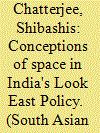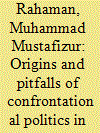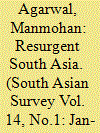|
|
|
Sort Order |
|
|
|
Items / Page
|
|
|
|
|
|
|
| Srl | Item |
| 1 |
ID:
079890


|
|
|
|
|
| Publication |
2007.
|
| Summary/Abstract |
Child malnutrition is the most pressing problem of the world, damaging to both children and nations. Malnutrition is costing poor countries up to 3 per cent of their yearly GDP. The pessimistic scenario suggests that child malnourishment will increase from 166 to 175 million children by 2020. Therefore, a detailed analysis of the plight of these children, and the root causes of malnutrition, are of paramount importance. The underlying causes of undernutrition vary from poverty, low levels of education and poor access to health services. The high levels of undernutrition in children and women in South Asia and Sub-Saharan Africa pose a major challenge for child survival and development. The examples of Thailand, Vietnam and China show that the problem of malnourishment is entirely preventable. Areas of intervention that will be most successful and the key policy priorities for each major developing region need to be identified.
|
|
|
|
|
|
|
|
|
|
|
|
|
|
|
|
| 2 |
ID:
079886


|
|
|
|
|
| Publication |
2007.
|
| Summary/Abstract |
There are three possible future articulations of India's Look East policy, each underpinned by a different conceptual orientation. Firstly, the Look East policy might be conceived as an extended security trajectory to project India's legitimate power and resist growing Chinese domination of the region. A second vision sees the Look East drive primarily as a strategy of economic cooperation based on globalisation and the pursuit of similar liberal policies by all the major states of the region. The third vision argues for a communitarian reading of the Look East venture, interpreting it in terms of sub-nationalisms and soft border exercises. While power, prosperity and community can be desired in equal measure, their policy implications vary, resulting in uneasy compromises, awkward bottlenecks and policy indecisions. Till India decides which image of space it wants to pursue, the power, market and community visions of the Look East initiative would keep playing against each other, generating complementarities as well as frictions
|
|
|
|
|
|
|
|
|
|
|
|
|
|
|
|
| 3 |
ID:
079887


|
|
|
|
|
| Publication |
2007.
|
| Summary/Abstract |
Securitisation has been the method of choice for non-realist international relations theorists, especially those seeking to understand state responses to terrorism. It has proved effective in discerning various types of actors and the manner in which they respond, legitimise and confer legitimacy on anti-terrorist activity. Securitisation, however, has been unable to address two crucial aspects of the legitimising process. First, it has been unable to negotiate with the fact that in most states (even liberal democratic ones) 'emergency' legislation is written into the normal legal structure, hence removing the requirement for securitisation. Second, and following from the first, securitisation actually occurs in many cases without the direct reference to existential threats. Using the Indian state's responses to the Naxalite and Khalistan movements, this article argues for a re-evaluation of the nature of the state and security, if securitisation is to maintain its conceptual coherence and operationalisability
|
|
|
|
|
|
|
|
|
|
|
|
|
|
|
|
| 4 |
ID:
079888


|
|
|
|
|
| Publication |
2007.
|
| Summary/Abstract |
Bangladesh is a relatively young democracy that gained its independence in 1971. The reestablishment of parliamentary democracy in 1991 following years of military dictatorship and the introduction of a non-party caretaker government were important achievements of the country in its democratic journey. In recent years however, confrontational politics has become a serious threat to democracy and development in Bangladesh. It is no longer an internal issue; it has also become a major concern of international donors to Bangladesh and the region as a whole
|
|
|
|
|
|
|
|
|
|
|
|
|
|
|
|
| 5 |
ID:
079884


|
|
|
|
|
| Publication |
2007.
|
| Summary/Abstract |
The absence of official relations between Pakistan and Israel underscores the difficulties facing Pakistani leaders to modify their long-held position towards Israel. The ongoing public debate in the country over the issue of normalisation is part of an exercise to prepare the sceptic and conservative public. Over the years, political pragmatism had compelled Pakistan to deal with Israel, albeit clandestinely. While the need for such a posture is understandable within the narrow domestic context, the historical similarities between Pakistan and Israel and the changing Middle East dynamics cannot be ignored. While a meaningful resolution of Israel's conflict with the Palestinians might be an appropriate moment for Pakistani-Israeli normalisation, at least in the short run, Islamabad's moves towards Israel would be guided by the attitude and reactions of its powerful friends and allies in the Middle East such as Saudi Arabia. Nevertheless, the absence of relations has been primarily a Pakistani decision. Hence any modification of this situation would have to come from Islamabad.
|
|
|
|
|
|
|
|
|
|
|
|
|
|
|
|
| 6 |
ID:
079883


|
|
|
|
|
| Publication |
2007.
|
| Summary/Abstract |
This article analyses the performance of the South Asian economies in the context of the evolution of the world economy. Recent years have seen considerable liberalisation of trade and capital flows in practically all countries, particularly developing countries. Trade has, consequently, expanded and developing countries are relying more on private flows than on aid to finance their balance of payments deficits. The performance of most developing countries has suffered since the oil price rises in 1974-77. Asian countries are an exception to this as they have grown rapidly. Growth rates in South Asian countries, after lagging behind those in East Asia, now seem to be catching up. Savings and investment rates have been increasing, as also exports. India, among the South Asian countries, is most likely to maintain a rapid growth rate. Manufactured goods feature more prominently in its economic structure and exports, and manufactures tend to show more dynamism. Also, the rapid growth of exports of commercial services, which have been growing particularly rapidly in the world economy, augurs well for the future.
|
|
|
|
|
|
|
|
|
|
|
|
|
|
|
|
| 7 |
ID:
079885


|
|
|
|
|
| Publication |
2007.
|
| Summary/Abstract |
Though there is no formally enforced press censorship in Pakistan, journalists have been indirectly forced to curtail their reporting due to various external reasons. This article examines the print media's potential role in Pakistan and identifies the direct external causes of self-censorship such as unofficial government controls, the oligopolistic newspaper ownership structure, the legal system and the lack of security for journalists. In addition, the paper looks at specific structural characteristics of the Pakistani print media that have created an environment for self-censorship to thrive, namely the reach and accessibility of the print media and the isolation of the Pakistani journalist from the international community. Finally, the paper puts forth three strategic recommendations to address the problem of self-censorship, first, legal reform to create an environment conducive to free journalism; second, ownership reform to increase plurality and create free market competition in the newspaper industry; and third, development of a self-regulating, professional Pakistani journalist association.
|
|
|
|
|
|
|
|
|
|
|
|
|
|
|
|
| 8 |
ID:
079889


|
|
|
|
|
| Publication |
2007.
|
| Summary/Abstract |
Numerous suggestions and proposals have been made on how to manage the borders in South Asia. This article analyses these proposals, including soft and open borders, fencing and making borders irrelevant. With the concept of borders undergoing a tremendous change in the last two decades, the article first looks at how the concept of security has evolved and the role that borders play in the new strategic calculus. The article then adopts a historical perspective on the geopolitical and strategic ground realities relating to borders in South Asia. How did borders evolve in South Asia, what kind of movements have been taking place ever since, and how have these two factors shaped the security concerns of respective governments relating to borders? Finally, the article studies the applicability of various proposals and assesses the best border policy options available to states in South Asia, given the ground realities
|
|
|
|
|
|
|
|
|
|
|
|
|
|
|
|
|
|
|
|
|